Human Resource Management Report: Employee Practices and Legislation
VerifiedAdded on 2023/01/13
|20
|6360
|100
Report
AI Summary
This report analyzes Human Resource Management (HRM) principles through a case study of TESCO, a multinational retail organization. The report is divided into two parts: Part 1 focuses on the development of an employee induction manual, examining the functions and purpose of HRM in workforce planning and resourcing, comparing the strengths and weaknesses of different recruitment and selection approaches, and outlining the benefits of various HRM practices for both employees and employers. It also explores how HRM practices impact organizational productivity and profit. Part 2 centers on the job application process, explaining the significance of employees in influencing HRM decision-making, detailing key elements of employee legislation and their impact on HRM decisions, and applying HRM practices in a practical context. The report covers managerial and operative functions, best-fit versus best-practice approaches, and internal/external recruitment strategies. It also addresses the importance of workforce planning and employee motivation within TESCO, providing a comprehensive overview of HRM in a real-world context.
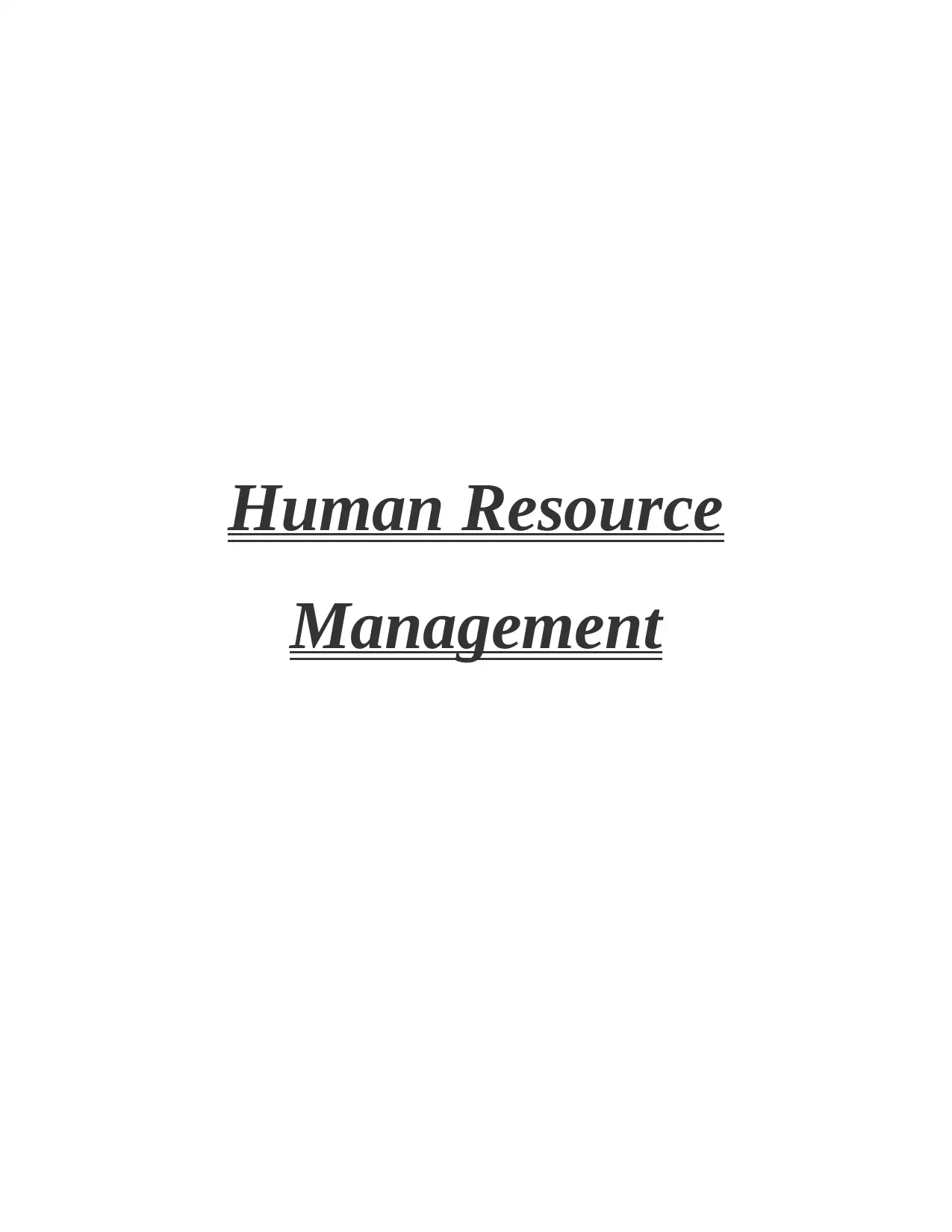
Human Resource
Management
Management
Paraphrase This Document
Need a fresh take? Get an instant paraphrase of this document with our AI Paraphraser
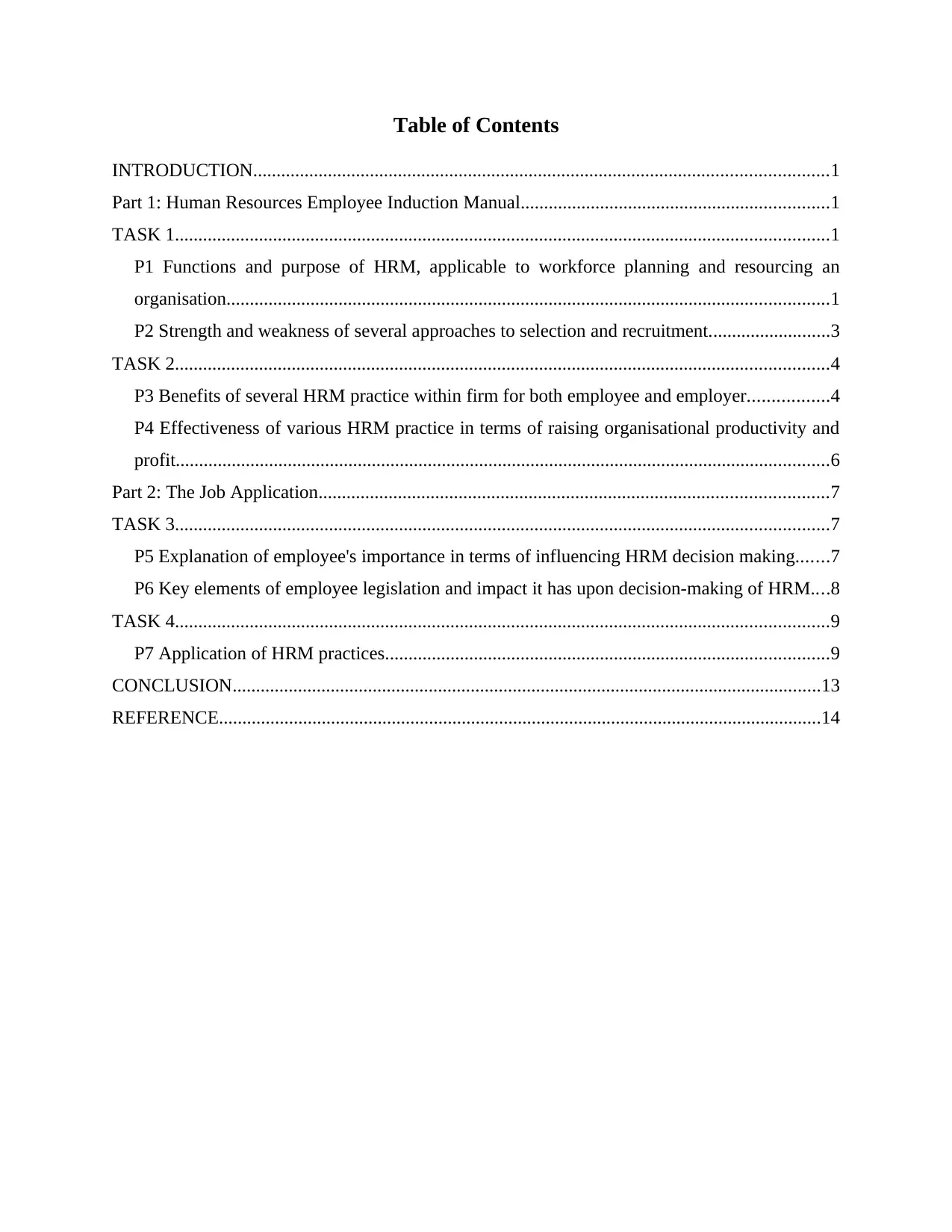
Table of Contents
INTRODUCTION...........................................................................................................................1
Part 1: Human Resources Employee Induction Manual..................................................................1
TASK 1............................................................................................................................................1
P1 Functions and purpose of HRM, applicable to workforce planning and resourcing an
organisation.................................................................................................................................1
P2 Strength and weakness of several approaches to selection and recruitment..........................3
TASK 2............................................................................................................................................4
P3 Benefits of several HRM practice within firm for both employee and employer.................4
P4 Effectiveness of various HRM practice in terms of raising organisational productivity and
profit............................................................................................................................................6
Part 2: The Job Application.............................................................................................................7
TASK 3............................................................................................................................................7
P5 Explanation of employee's importance in terms of influencing HRM decision making.......7
P6 Key elements of employee legislation and impact it has upon decision-making of HRM....8
TASK 4............................................................................................................................................9
P7 Application of HRM practices...............................................................................................9
CONCLUSION..............................................................................................................................13
REFERENCE.................................................................................................................................14
INTRODUCTION...........................................................................................................................1
Part 1: Human Resources Employee Induction Manual..................................................................1
TASK 1............................................................................................................................................1
P1 Functions and purpose of HRM, applicable to workforce planning and resourcing an
organisation.................................................................................................................................1
P2 Strength and weakness of several approaches to selection and recruitment..........................3
TASK 2............................................................................................................................................4
P3 Benefits of several HRM practice within firm for both employee and employer.................4
P4 Effectiveness of various HRM practice in terms of raising organisational productivity and
profit............................................................................................................................................6
Part 2: The Job Application.............................................................................................................7
TASK 3............................................................................................................................................7
P5 Explanation of employee's importance in terms of influencing HRM decision making.......7
P6 Key elements of employee legislation and impact it has upon decision-making of HRM....8
TASK 4............................................................................................................................................9
P7 Application of HRM practices...............................................................................................9
CONCLUSION..............................................................................................................................13
REFERENCE.................................................................................................................................14
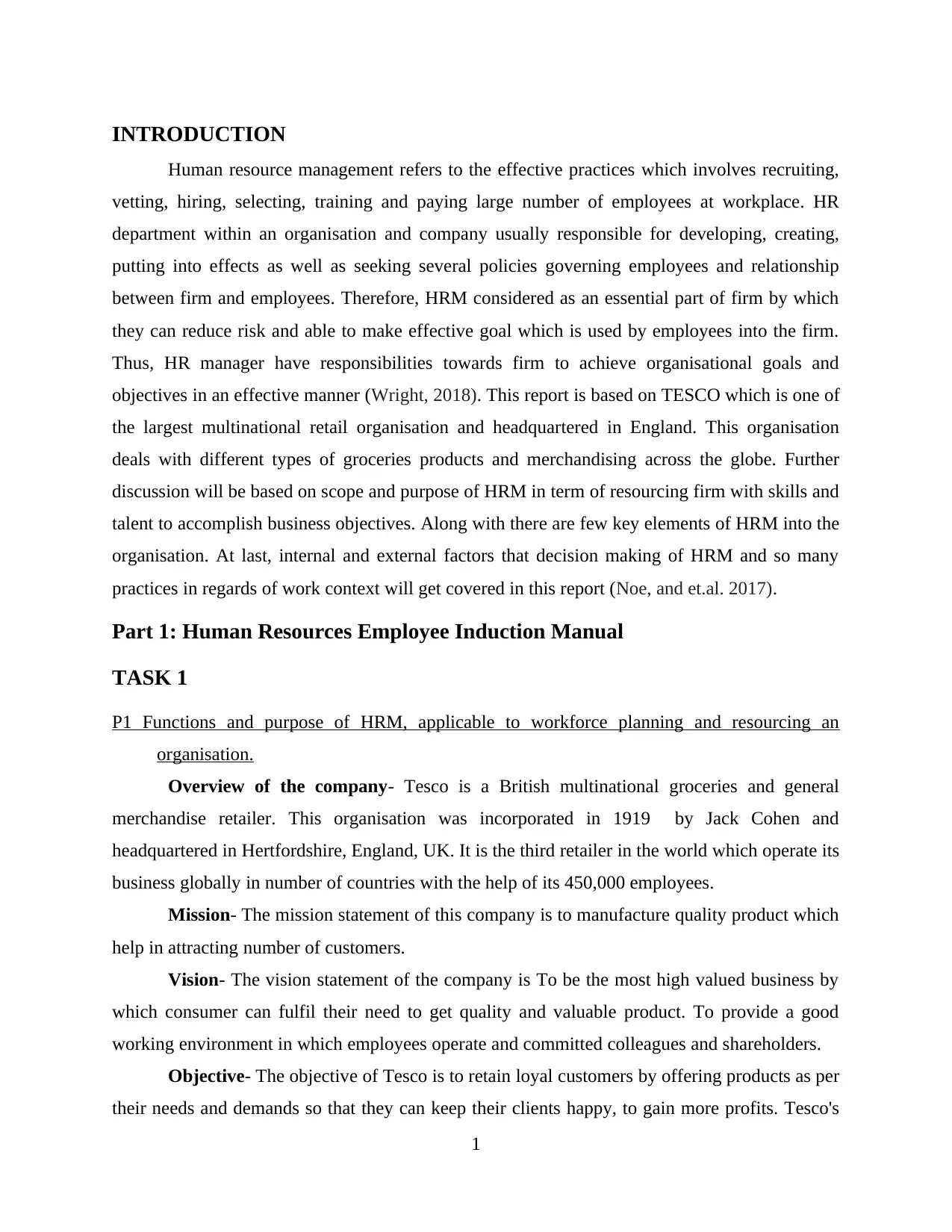
INTRODUCTION
Human resource management refers to the effective practices which involves recruiting,
vetting, hiring, selecting, training and paying large number of employees at workplace. HR
department within an organisation and company usually responsible for developing, creating,
putting into effects as well as seeking several policies governing employees and relationship
between firm and employees. Therefore, HRM considered as an essential part of firm by which
they can reduce risk and able to make effective goal which is used by employees into the firm.
Thus, HR manager have responsibilities towards firm to achieve organisational goals and
objectives in an effective manner (Wright, 2018). This report is based on TESCO which is one of
the largest multinational retail organisation and headquartered in England. This organisation
deals with different types of groceries products and merchandising across the globe. Further
discussion will be based on scope and purpose of HRM in term of resourcing firm with skills and
talent to accomplish business objectives. Along with there are few key elements of HRM into the
organisation. At last, internal and external factors that decision making of HRM and so many
practices in regards of work context will get covered in this report (Noe, and et.al. 2017).
Part 1: Human Resources Employee Induction Manual
TASK 1
P1 Functions and purpose of HRM, applicable to workforce planning and resourcing an
organisation.
Overview of the company- Tesco is a British multinational groceries and general
merchandise retailer. This organisation was incorporated in 1919 by Jack Cohen and
headquartered in Hertfordshire, England, UK. It is the third retailer in the world which operate its
business globally in number of countries with the help of its 450,000 employees.
Mission- The mission statement of this company is to manufacture quality product which
help in attracting number of customers.
Vision- The vision statement of the company is To be the most high valued business by
which consumer can fulfil their need to get quality and valuable product. To provide a good
working environment in which employees operate and committed colleagues and shareholders.
Objective- The objective of Tesco is to retain loyal customers by offering products as per
their needs and demands so that they can keep their clients happy, to gain more profits. Tesco's
1
Human resource management refers to the effective practices which involves recruiting,
vetting, hiring, selecting, training and paying large number of employees at workplace. HR
department within an organisation and company usually responsible for developing, creating,
putting into effects as well as seeking several policies governing employees and relationship
between firm and employees. Therefore, HRM considered as an essential part of firm by which
they can reduce risk and able to make effective goal which is used by employees into the firm.
Thus, HR manager have responsibilities towards firm to achieve organisational goals and
objectives in an effective manner (Wright, 2018). This report is based on TESCO which is one of
the largest multinational retail organisation and headquartered in England. This organisation
deals with different types of groceries products and merchandising across the globe. Further
discussion will be based on scope and purpose of HRM in term of resourcing firm with skills and
talent to accomplish business objectives. Along with there are few key elements of HRM into the
organisation. At last, internal and external factors that decision making of HRM and so many
practices in regards of work context will get covered in this report (Noe, and et.al. 2017).
Part 1: Human Resources Employee Induction Manual
TASK 1
P1 Functions and purpose of HRM, applicable to workforce planning and resourcing an
organisation.
Overview of the company- Tesco is a British multinational groceries and general
merchandise retailer. This organisation was incorporated in 1919 by Jack Cohen and
headquartered in Hertfordshire, England, UK. It is the third retailer in the world which operate its
business globally in number of countries with the help of its 450,000 employees.
Mission- The mission statement of this company is to manufacture quality product which
help in attracting number of customers.
Vision- The vision statement of the company is To be the most high valued business by
which consumer can fulfil their need to get quality and valuable product. To provide a good
working environment in which employees operate and committed colleagues and shareholders.
Objective- The objective of Tesco is to retain loyal customers by offering products as per
their needs and demands so that they can keep their clients happy, to gain more profits. Tesco's
1
⊘ This is a preview!⊘
Do you want full access?
Subscribe today to unlock all pages.

Trusted by 1+ million students worldwide
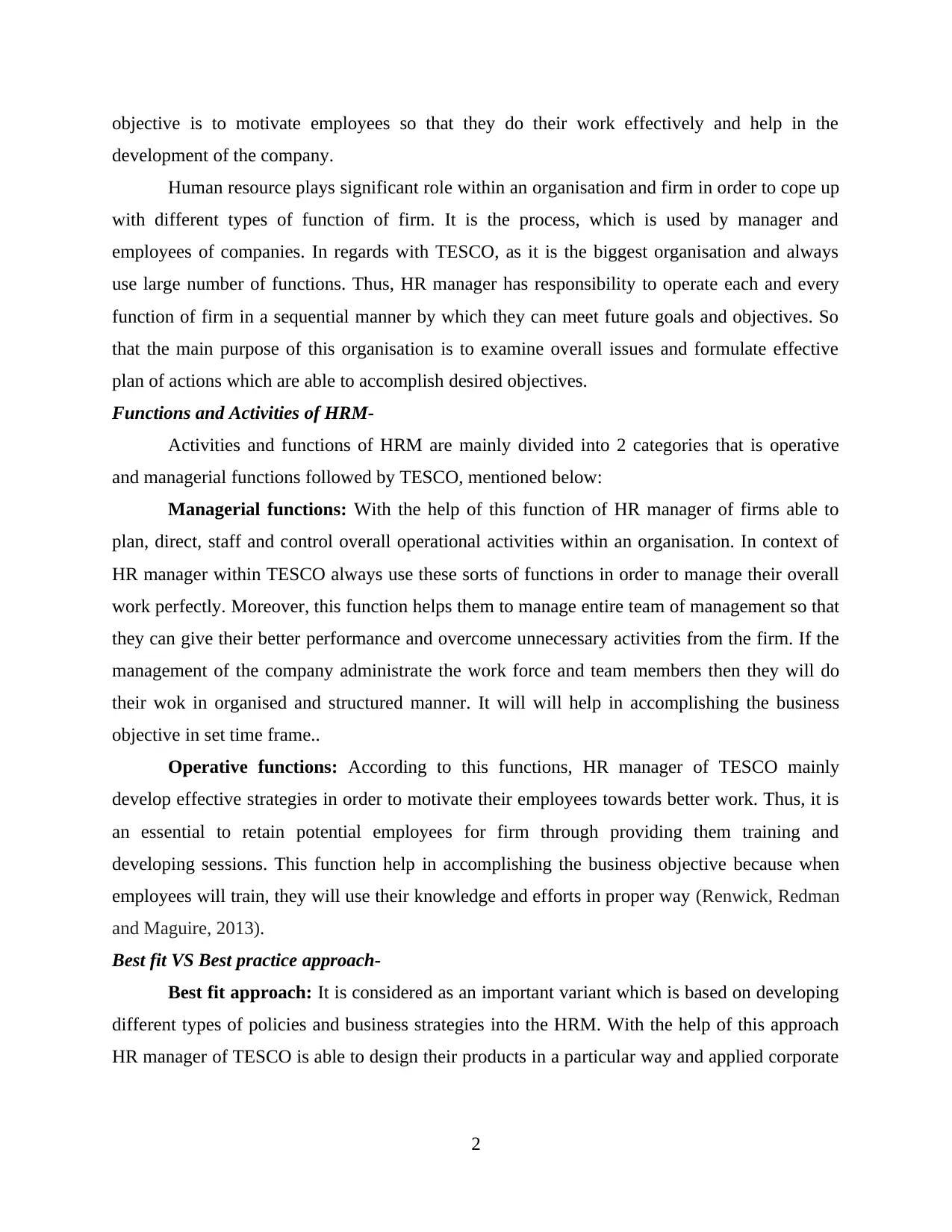
objective is to motivate employees so that they do their work effectively and help in the
development of the company.
Human resource plays significant role within an organisation and firm in order to cope up
with different types of function of firm. It is the process, which is used by manager and
employees of companies. In regards with TESCO, as it is the biggest organisation and always
use large number of functions. Thus, HR manager has responsibility to operate each and every
function of firm in a sequential manner by which they can meet future goals and objectives. So
that the main purpose of this organisation is to examine overall issues and formulate effective
plan of actions which are able to accomplish desired objectives.
Functions and Activities of HRM-
Activities and functions of HRM are mainly divided into 2 categories that is operative
and managerial functions followed by TESCO, mentioned below:
Managerial functions: With the help of this function of HR manager of firms able to
plan, direct, staff and control overall operational activities within an organisation. In context of
HR manager within TESCO always use these sorts of functions in order to manage their overall
work perfectly. Moreover, this function helps them to manage entire team of management so that
they can give their better performance and overcome unnecessary activities from the firm. If the
management of the company administrate the work force and team members then they will do
their wok in organised and structured manner. It will will help in accomplishing the business
objective in set time frame..
Operative functions: According to this functions, HR manager of TESCO mainly
develop effective strategies in order to motivate their employees towards better work. Thus, it is
an essential to retain potential employees for firm through providing them training and
developing sessions. This function help in accomplishing the business objective because when
employees will train, they will use their knowledge and efforts in proper way (Renwick, Redman
and Maguire, 2013).
Best fit VS Best practice approach-
Best fit approach: It is considered as an important variant which is based on developing
different types of policies and business strategies into the HRM. With the help of this approach
HR manager of TESCO is able to design their products in a particular way and applied corporate
2
development of the company.
Human resource plays significant role within an organisation and firm in order to cope up
with different types of function of firm. It is the process, which is used by manager and
employees of companies. In regards with TESCO, as it is the biggest organisation and always
use large number of functions. Thus, HR manager has responsibility to operate each and every
function of firm in a sequential manner by which they can meet future goals and objectives. So
that the main purpose of this organisation is to examine overall issues and formulate effective
plan of actions which are able to accomplish desired objectives.
Functions and Activities of HRM-
Activities and functions of HRM are mainly divided into 2 categories that is operative
and managerial functions followed by TESCO, mentioned below:
Managerial functions: With the help of this function of HR manager of firms able to
plan, direct, staff and control overall operational activities within an organisation. In context of
HR manager within TESCO always use these sorts of functions in order to manage their overall
work perfectly. Moreover, this function helps them to manage entire team of management so that
they can give their better performance and overcome unnecessary activities from the firm. If the
management of the company administrate the work force and team members then they will do
their wok in organised and structured manner. It will will help in accomplishing the business
objective in set time frame..
Operative functions: According to this functions, HR manager of TESCO mainly
develop effective strategies in order to motivate their employees towards better work. Thus, it is
an essential to retain potential employees for firm through providing them training and
developing sessions. This function help in accomplishing the business objective because when
employees will train, they will use their knowledge and efforts in proper way (Renwick, Redman
and Maguire, 2013).
Best fit VS Best practice approach-
Best fit approach: It is considered as an important variant which is based on developing
different types of policies and business strategies into the HRM. With the help of this approach
HR manager of TESCO is able to design their products in a particular way and applied corporate
2
Paraphrase This Document
Need a fresh take? Get an instant paraphrase of this document with our AI Paraphraser
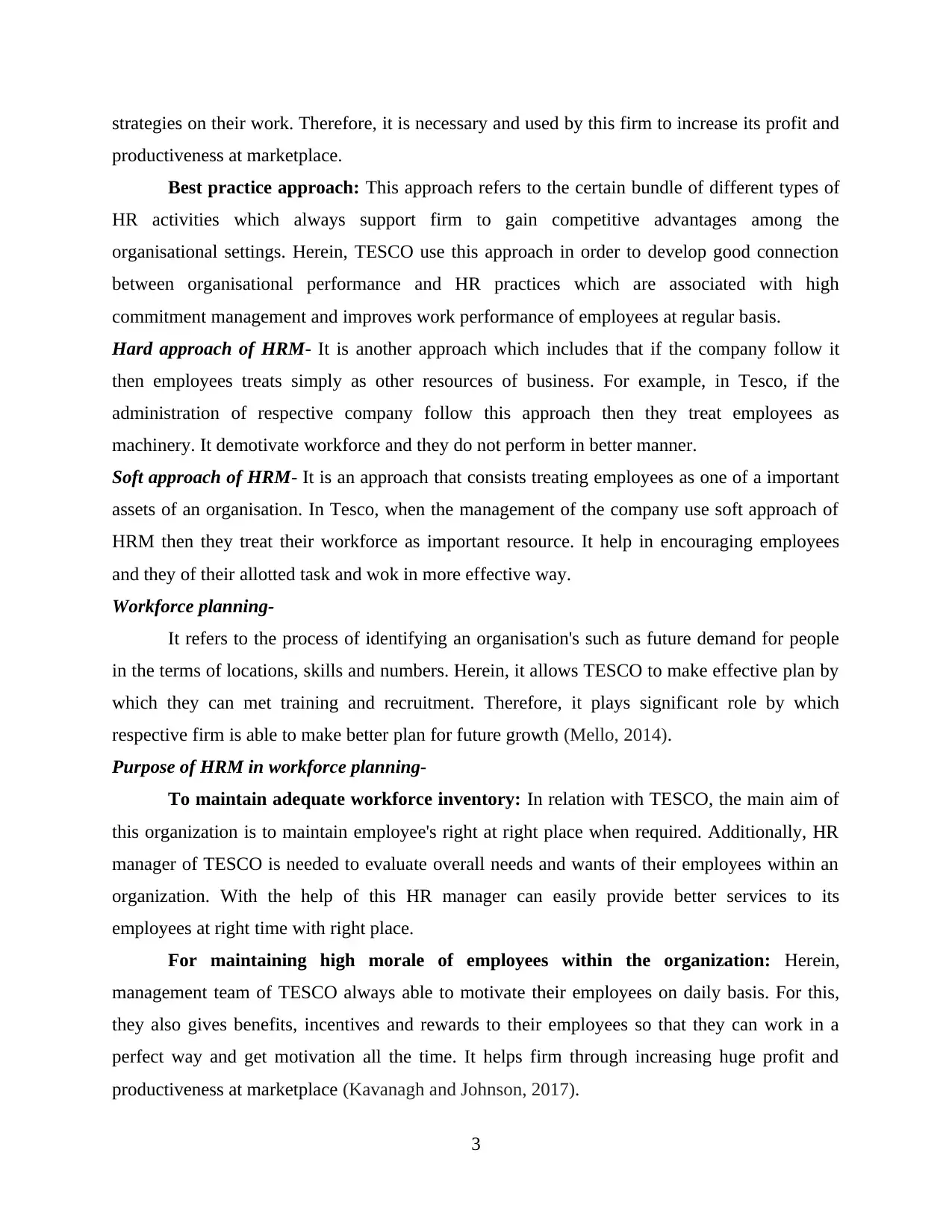
strategies on their work. Therefore, it is necessary and used by this firm to increase its profit and
productiveness at marketplace.
Best practice approach: This approach refers to the certain bundle of different types of
HR activities which always support firm to gain competitive advantages among the
organisational settings. Herein, TESCO use this approach in order to develop good connection
between organisational performance and HR practices which are associated with high
commitment management and improves work performance of employees at regular basis.
Hard approach of HRM- It is another approach which includes that if the company follow it
then employees treats simply as other resources of business. For example, in Tesco, if the
administration of respective company follow this approach then they treat employees as
machinery. It demotivate workforce and they do not perform in better manner.
Soft approach of HRM- It is an approach that consists treating employees as one of a important
assets of an organisation. In Tesco, when the management of the company use soft approach of
HRM then they treat their workforce as important resource. It help in encouraging employees
and they of their allotted task and wok in more effective way.
Workforce planning-
It refers to the process of identifying an organisation's such as future demand for people
in the terms of locations, skills and numbers. Herein, it allows TESCO to make effective plan by
which they can met training and recruitment. Therefore, it plays significant role by which
respective firm is able to make better plan for future growth (Mello, 2014).
Purpose of HRM in workforce planning-
To maintain adequate workforce inventory: In relation with TESCO, the main aim of
this organization is to maintain employee's right at right place when required. Additionally, HR
manager of TESCO is needed to evaluate overall needs and wants of their employees within an
organization. With the help of this HR manager can easily provide better services to its
employees at right time with right place.
For maintaining high morale of employees within the organization: Herein,
management team of TESCO always able to motivate their employees on daily basis. For this,
they also gives benefits, incentives and rewards to their employees so that they can work in a
perfect way and get motivation all the time. It helps firm through increasing huge profit and
productiveness at marketplace (Kavanagh and Johnson, 2017).
3
productiveness at marketplace.
Best practice approach: This approach refers to the certain bundle of different types of
HR activities which always support firm to gain competitive advantages among the
organisational settings. Herein, TESCO use this approach in order to develop good connection
between organisational performance and HR practices which are associated with high
commitment management and improves work performance of employees at regular basis.
Hard approach of HRM- It is another approach which includes that if the company follow it
then employees treats simply as other resources of business. For example, in Tesco, if the
administration of respective company follow this approach then they treat employees as
machinery. It demotivate workforce and they do not perform in better manner.
Soft approach of HRM- It is an approach that consists treating employees as one of a important
assets of an organisation. In Tesco, when the management of the company use soft approach of
HRM then they treat their workforce as important resource. It help in encouraging employees
and they of their allotted task and wok in more effective way.
Workforce planning-
It refers to the process of identifying an organisation's such as future demand for people
in the terms of locations, skills and numbers. Herein, it allows TESCO to make effective plan by
which they can met training and recruitment. Therefore, it plays significant role by which
respective firm is able to make better plan for future growth (Mello, 2014).
Purpose of HRM in workforce planning-
To maintain adequate workforce inventory: In relation with TESCO, the main aim of
this organization is to maintain employee's right at right place when required. Additionally, HR
manager of TESCO is needed to evaluate overall needs and wants of their employees within an
organization. With the help of this HR manager can easily provide better services to its
employees at right time with right place.
For maintaining high morale of employees within the organization: Herein,
management team of TESCO always able to motivate their employees on daily basis. For this,
they also gives benefits, incentives and rewards to their employees so that they can work in a
perfect way and get motivation all the time. It helps firm through increasing huge profit and
productiveness at marketplace (Kavanagh and Johnson, 2017).
3
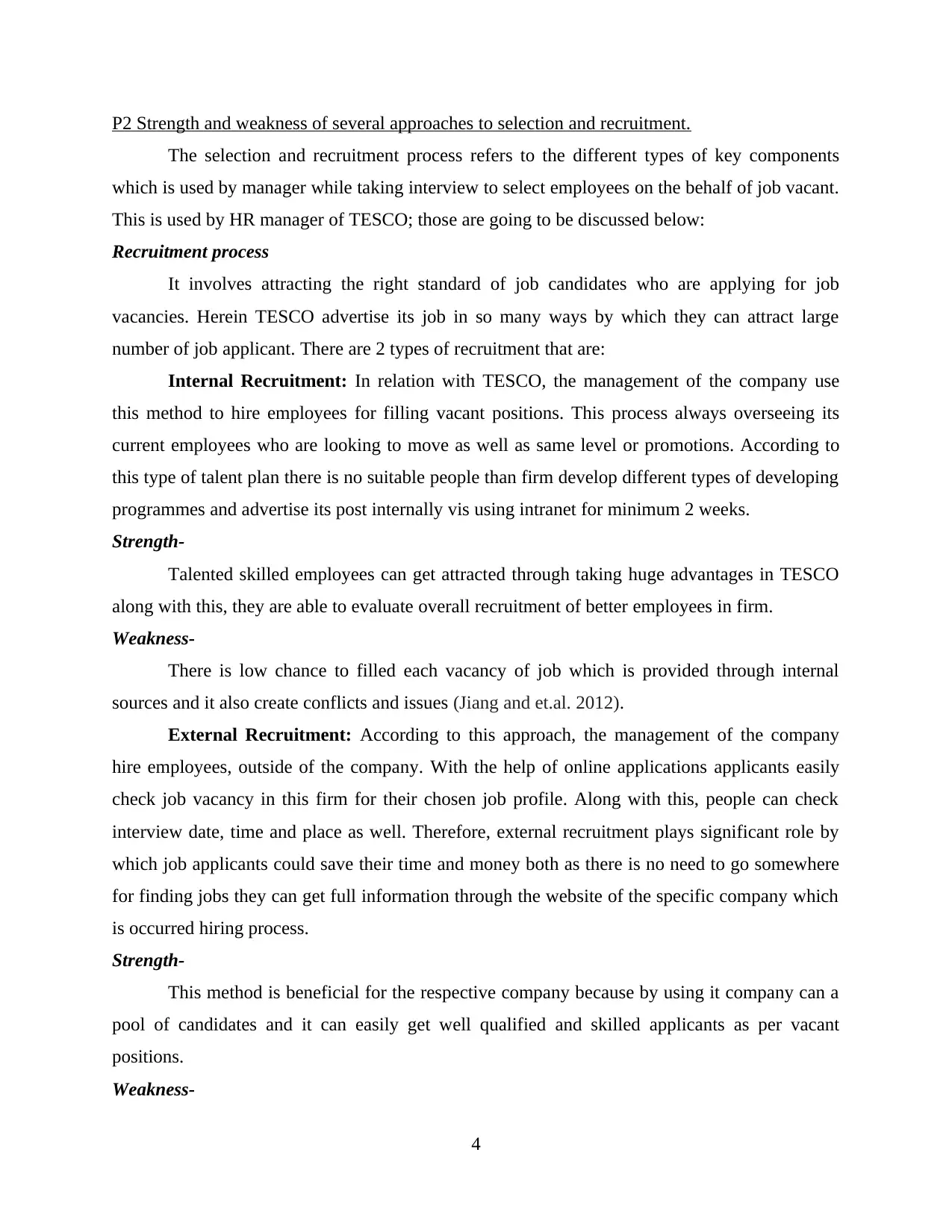
P2 Strength and weakness of several approaches to selection and recruitment.
The selection and recruitment process refers to the different types of key components
which is used by manager while taking interview to select employees on the behalf of job vacant.
This is used by HR manager of TESCO; those are going to be discussed below:
Recruitment process
It involves attracting the right standard of job candidates who are applying for job
vacancies. Herein TESCO advertise its job in so many ways by which they can attract large
number of job applicant. There are 2 types of recruitment that are:
Internal Recruitment: In relation with TESCO, the management of the company use
this method to hire employees for filling vacant positions. This process always overseeing its
current employees who are looking to move as well as same level or promotions. According to
this type of talent plan there is no suitable people than firm develop different types of developing
programmes and advertise its post internally vis using intranet for minimum 2 weeks.
Strength-
Talented skilled employees can get attracted through taking huge advantages in TESCO
along with this, they are able to evaluate overall recruitment of better employees in firm.
Weakness-
There is low chance to filled each vacancy of job which is provided through internal
sources and it also create conflicts and issues (Jiang and et.al. 2012).
External Recruitment: According to this approach, the management of the company
hire employees, outside of the company. With the help of online applications applicants easily
check job vacancy in this firm for their chosen job profile. Along with this, people can check
interview date, time and place as well. Therefore, external recruitment plays significant role by
which job applicants could save their time and money both as there is no need to go somewhere
for finding jobs they can get full information through the website of the specific company which
is occurred hiring process.
Strength-
This method is beneficial for the respective company because by using it company can a
pool of candidates and it can easily get well qualified and skilled applicants as per vacant
positions.
Weakness-
4
The selection and recruitment process refers to the different types of key components
which is used by manager while taking interview to select employees on the behalf of job vacant.
This is used by HR manager of TESCO; those are going to be discussed below:
Recruitment process
It involves attracting the right standard of job candidates who are applying for job
vacancies. Herein TESCO advertise its job in so many ways by which they can attract large
number of job applicant. There are 2 types of recruitment that are:
Internal Recruitment: In relation with TESCO, the management of the company use
this method to hire employees for filling vacant positions. This process always overseeing its
current employees who are looking to move as well as same level or promotions. According to
this type of talent plan there is no suitable people than firm develop different types of developing
programmes and advertise its post internally vis using intranet for minimum 2 weeks.
Strength-
Talented skilled employees can get attracted through taking huge advantages in TESCO
along with this, they are able to evaluate overall recruitment of better employees in firm.
Weakness-
There is low chance to filled each vacancy of job which is provided through internal
sources and it also create conflicts and issues (Jiang and et.al. 2012).
External Recruitment: According to this approach, the management of the company
hire employees, outside of the company. With the help of online applications applicants easily
check job vacancy in this firm for their chosen job profile. Along with this, people can check
interview date, time and place as well. Therefore, external recruitment plays significant role by
which job applicants could save their time and money both as there is no need to go somewhere
for finding jobs they can get full information through the website of the specific company which
is occurred hiring process.
Strength-
This method is beneficial for the respective company because by using it company can a
pool of candidates and it can easily get well qualified and skilled applicants as per vacant
positions.
Weakness-
4
⊘ This is a preview!⊘
Do you want full access?
Subscribe today to unlock all pages.

Trusted by 1+ million students worldwide
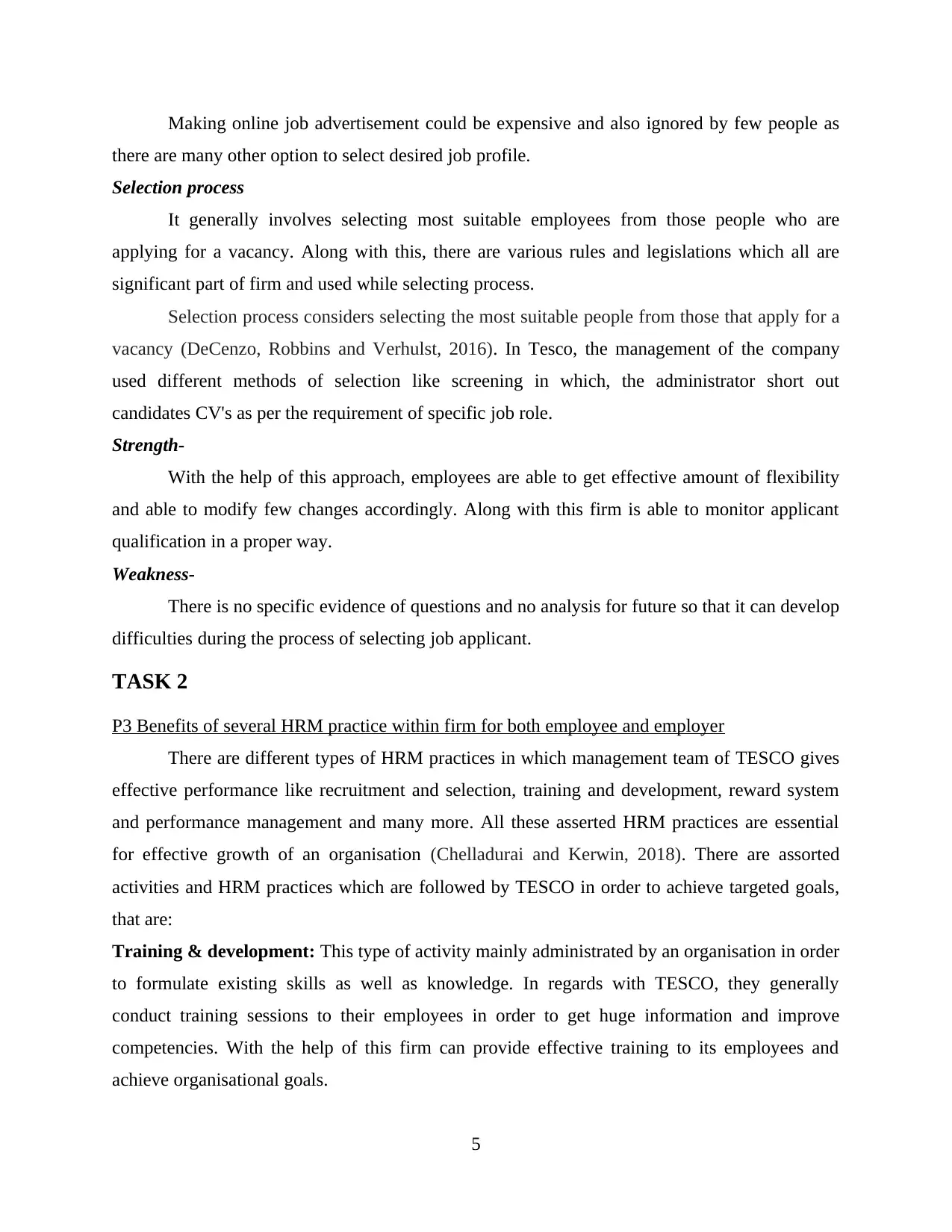
Making online job advertisement could be expensive and also ignored by few people as
there are many other option to select desired job profile.
Selection process
It generally involves selecting most suitable employees from those people who are
applying for a vacancy. Along with this, there are various rules and legislations which all are
significant part of firm and used while selecting process.
Selection process considers selecting the most suitable people from those that apply for a
vacancy (DeCenzo, Robbins and Verhulst, 2016). In Tesco, the management of the company
used different methods of selection like screening in which, the administrator short out
candidates CV's as per the requirement of specific job role.
Strength-
With the help of this approach, employees are able to get effective amount of flexibility
and able to modify few changes accordingly. Along with this firm is able to monitor applicant
qualification in a proper way.
Weakness-
There is no specific evidence of questions and no analysis for future so that it can develop
difficulties during the process of selecting job applicant.
TASK 2
P3 Benefits of several HRM practice within firm for both employee and employer
There are different types of HRM practices in which management team of TESCO gives
effective performance like recruitment and selection, training and development, reward system
and performance management and many more. All these asserted HRM practices are essential
for effective growth of an organisation (Chelladurai and Kerwin, 2018). There are assorted
activities and HRM practices which are followed by TESCO in order to achieve targeted goals,
that are:
Training & development: This type of activity mainly administrated by an organisation in order
to formulate existing skills as well as knowledge. In regards with TESCO, they generally
conduct training sessions to their employees in order to get huge information and improve
competencies. With the help of this firm can provide effective training to its employees and
achieve organisational goals.
5
there are many other option to select desired job profile.
Selection process
It generally involves selecting most suitable employees from those people who are
applying for a vacancy. Along with this, there are various rules and legislations which all are
significant part of firm and used while selecting process.
Selection process considers selecting the most suitable people from those that apply for a
vacancy (DeCenzo, Robbins and Verhulst, 2016). In Tesco, the management of the company
used different methods of selection like screening in which, the administrator short out
candidates CV's as per the requirement of specific job role.
Strength-
With the help of this approach, employees are able to get effective amount of flexibility
and able to modify few changes accordingly. Along with this firm is able to monitor applicant
qualification in a proper way.
Weakness-
There is no specific evidence of questions and no analysis for future so that it can develop
difficulties during the process of selecting job applicant.
TASK 2
P3 Benefits of several HRM practice within firm for both employee and employer
There are different types of HRM practices in which management team of TESCO gives
effective performance like recruitment and selection, training and development, reward system
and performance management and many more. All these asserted HRM practices are essential
for effective growth of an organisation (Chelladurai and Kerwin, 2018). There are assorted
activities and HRM practices which are followed by TESCO in order to achieve targeted goals,
that are:
Training & development: This type of activity mainly administrated by an organisation in order
to formulate existing skills as well as knowledge. In regards with TESCO, they generally
conduct training sessions to their employees in order to get huge information and improve
competencies. With the help of this firm can provide effective training to its employees and
achieve organisational goals.
5
Paraphrase This Document
Need a fresh take? Get an instant paraphrase of this document with our AI Paraphraser
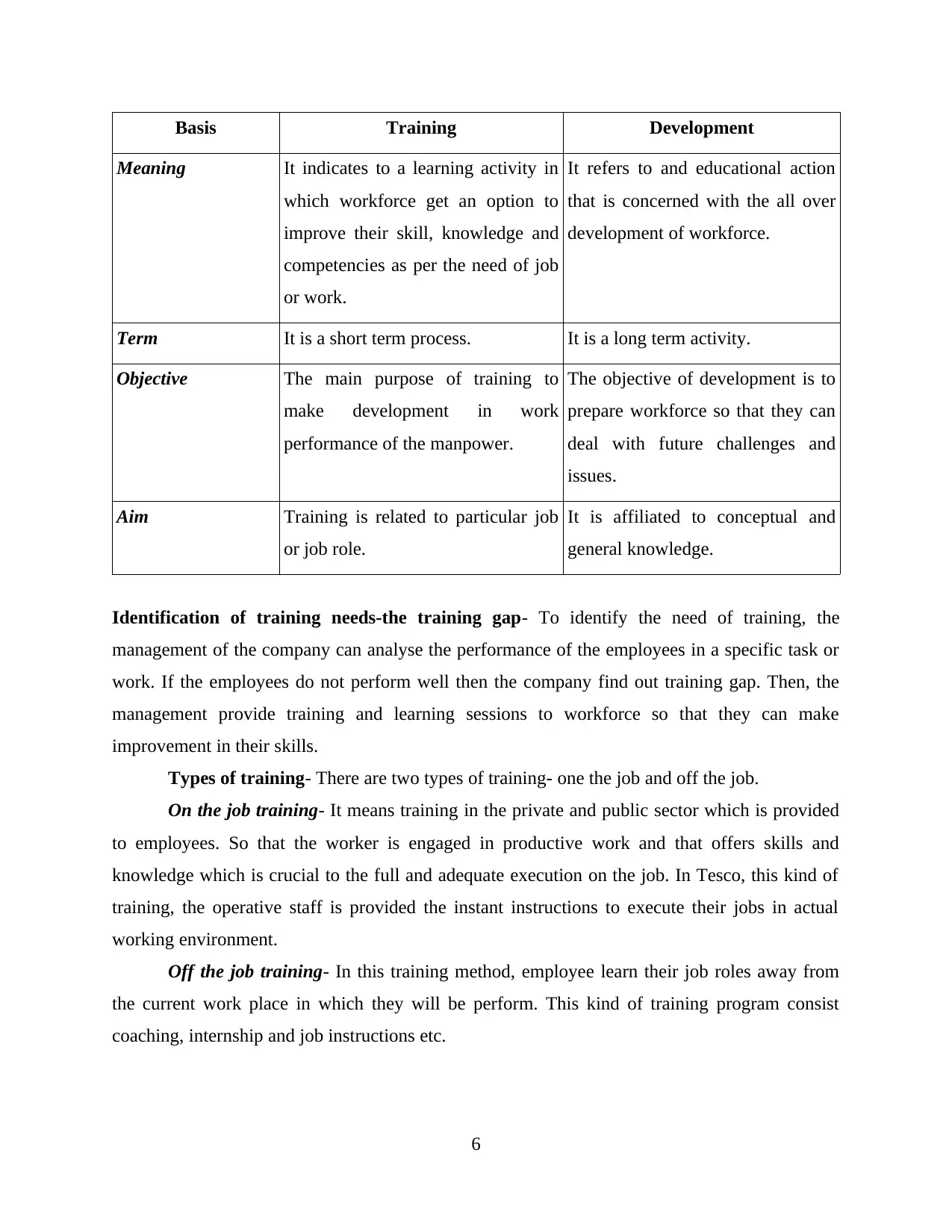
Basis Training Development
Meaning It indicates to a learning activity in
which workforce get an option to
improve their skill, knowledge and
competencies as per the need of job
or work.
It refers to and educational action
that is concerned with the all over
development of workforce.
Term It is a short term process. It is a long term activity.
Objective The main purpose of training to
make development in work
performance of the manpower.
The objective of development is to
prepare workforce so that they can
deal with future challenges and
issues.
Aim Training is related to particular job
or job role.
It is affiliated to conceptual and
general knowledge.
Identification of training needs-the training gap- To identify the need of training, the
management of the company can analyse the performance of the employees in a specific task or
work. If the employees do not perform well then the company find out training gap. Then, the
management provide training and learning sessions to workforce so that they can make
improvement in their skills.
Types of training- There are two types of training- one the job and off the job.
On the job training- It means training in the private and public sector which is provided
to employees. So that the worker is engaged in productive work and that offers skills and
knowledge which is crucial to the full and adequate execution on the job. In Tesco, this kind of
training, the operative staff is provided the instant instructions to execute their jobs in actual
working environment.
Off the job training- In this training method, employee learn their job roles away from
the current work place in which they will be perform. This kind of training program consist
coaching, internship and job instructions etc.
6
Meaning It indicates to a learning activity in
which workforce get an option to
improve their skill, knowledge and
competencies as per the need of job
or work.
It refers to and educational action
that is concerned with the all over
development of workforce.
Term It is a short term process. It is a long term activity.
Objective The main purpose of training to
make development in work
performance of the manpower.
The objective of development is to
prepare workforce so that they can
deal with future challenges and
issues.
Aim Training is related to particular job
or job role.
It is affiliated to conceptual and
general knowledge.
Identification of training needs-the training gap- To identify the need of training, the
management of the company can analyse the performance of the employees in a specific task or
work. If the employees do not perform well then the company find out training gap. Then, the
management provide training and learning sessions to workforce so that they can make
improvement in their skills.
Types of training- There are two types of training- one the job and off the job.
On the job training- It means training in the private and public sector which is provided
to employees. So that the worker is engaged in productive work and that offers skills and
knowledge which is crucial to the full and adequate execution on the job. In Tesco, this kind of
training, the operative staff is provided the instant instructions to execute their jobs in actual
working environment.
Off the job training- In this training method, employee learn their job roles away from
the current work place in which they will be perform. This kind of training program consist
coaching, internship and job instructions etc.
6
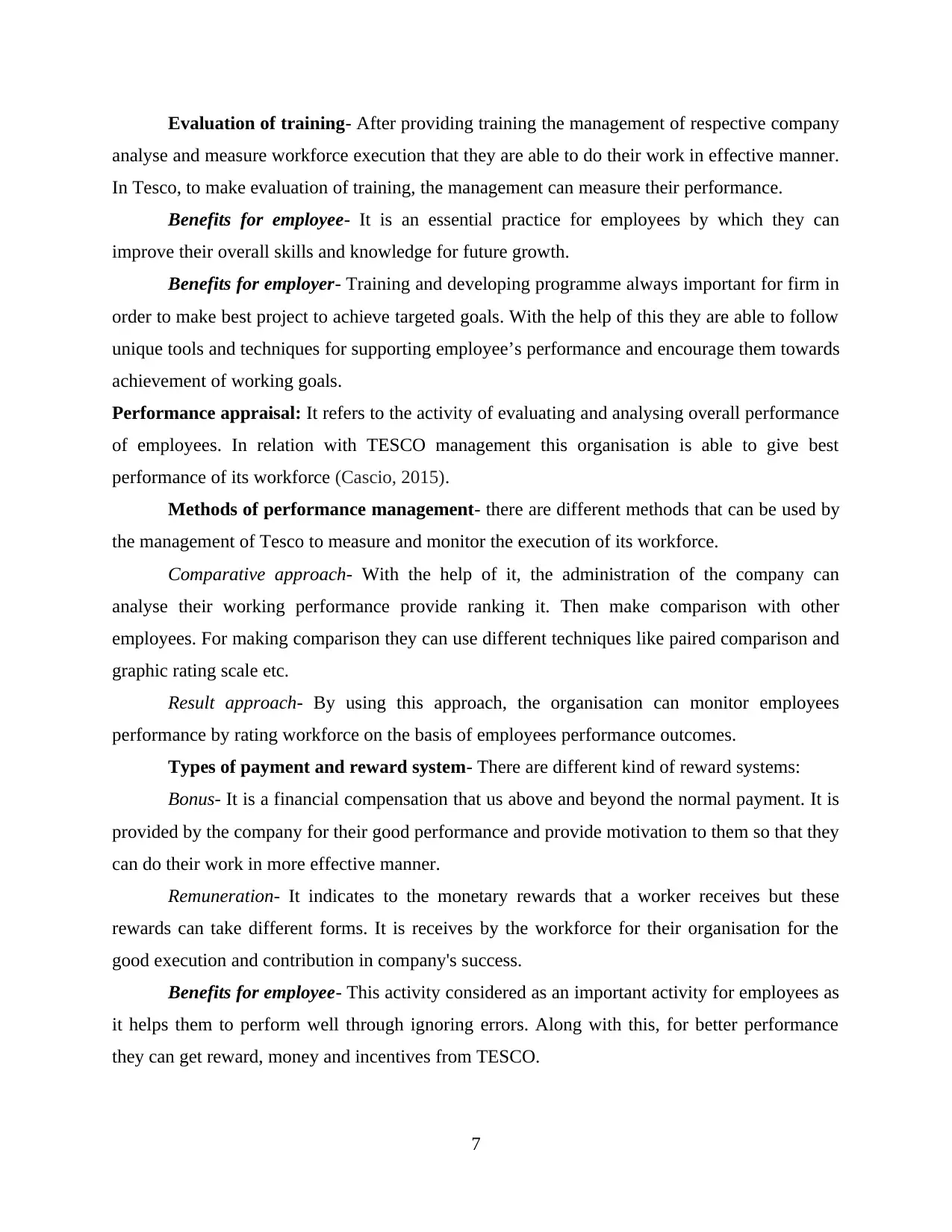
Evaluation of training- After providing training the management of respective company
analyse and measure workforce execution that they are able to do their work in effective manner.
In Tesco, to make evaluation of training, the management can measure their performance.
Benefits for employee- It is an essential practice for employees by which they can
improve their overall skills and knowledge for future growth.
Benefits for employer- Training and developing programme always important for firm in
order to make best project to achieve targeted goals. With the help of this they are able to follow
unique tools and techniques for supporting employee’s performance and encourage them towards
achievement of working goals.
Performance appraisal: It refers to the activity of evaluating and analysing overall performance
of employees. In relation with TESCO management this organisation is able to give best
performance of its workforce (Cascio, 2015).
Methods of performance management- there are different methods that can be used by
the management of Tesco to measure and monitor the execution of its workforce.
Comparative approach- With the help of it, the administration of the company can
analyse their working performance provide ranking it. Then make comparison with other
employees. For making comparison they can use different techniques like paired comparison and
graphic rating scale etc.
Result approach- By using this approach, the organisation can monitor employees
performance by rating workforce on the basis of employees performance outcomes.
Types of payment and reward system- There are different kind of reward systems:
Bonus- It is a financial compensation that us above and beyond the normal payment. It is
provided by the company for their good performance and provide motivation to them so that they
can do their work in more effective manner.
Remuneration- It indicates to the monetary rewards that a worker receives but these
rewards can take different forms. It is receives by the workforce for their organisation for the
good execution and contribution in company's success.
Benefits for employee- This activity considered as an important activity for employees as
it helps them to perform well through ignoring errors. Along with this, for better performance
they can get reward, money and incentives from TESCO.
7
analyse and measure workforce execution that they are able to do their work in effective manner.
In Tesco, to make evaluation of training, the management can measure their performance.
Benefits for employee- It is an essential practice for employees by which they can
improve their overall skills and knowledge for future growth.
Benefits for employer- Training and developing programme always important for firm in
order to make best project to achieve targeted goals. With the help of this they are able to follow
unique tools and techniques for supporting employee’s performance and encourage them towards
achievement of working goals.
Performance appraisal: It refers to the activity of evaluating and analysing overall performance
of employees. In relation with TESCO management this organisation is able to give best
performance of its workforce (Cascio, 2015).
Methods of performance management- there are different methods that can be used by
the management of Tesco to measure and monitor the execution of its workforce.
Comparative approach- With the help of it, the administration of the company can
analyse their working performance provide ranking it. Then make comparison with other
employees. For making comparison they can use different techniques like paired comparison and
graphic rating scale etc.
Result approach- By using this approach, the organisation can monitor employees
performance by rating workforce on the basis of employees performance outcomes.
Types of payment and reward system- There are different kind of reward systems:
Bonus- It is a financial compensation that us above and beyond the normal payment. It is
provided by the company for their good performance and provide motivation to them so that they
can do their work in more effective manner.
Remuneration- It indicates to the monetary rewards that a worker receives but these
rewards can take different forms. It is receives by the workforce for their organisation for the
good execution and contribution in company's success.
Benefits for employee- This activity considered as an important activity for employees as
it helps them to perform well through ignoring errors. Along with this, for better performance
they can get reward, money and incentives from TESCO.
7
⊘ This is a preview!⊘
Do you want full access?
Subscribe today to unlock all pages.

Trusted by 1+ million students worldwide
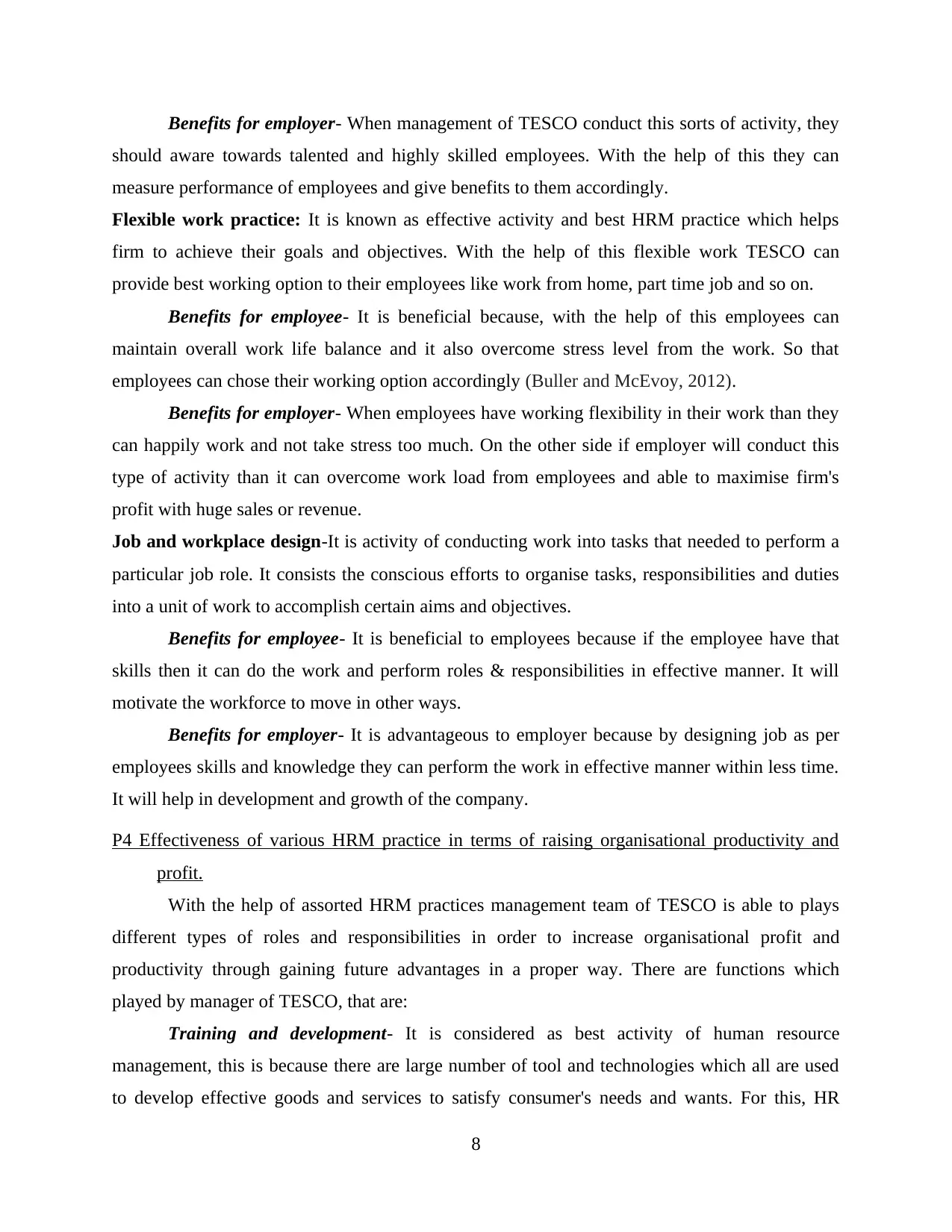
Benefits for employer- When management of TESCO conduct this sorts of activity, they
should aware towards talented and highly skilled employees. With the help of this they can
measure performance of employees and give benefits to them accordingly.
Flexible work practice: It is known as effective activity and best HRM practice which helps
firm to achieve their goals and objectives. With the help of this flexible work TESCO can
provide best working option to their employees like work from home, part time job and so on.
Benefits for employee- It is beneficial because, with the help of this employees can
maintain overall work life balance and it also overcome stress level from the work. So that
employees can chose their working option accordingly (Buller and McEvoy, 2012).
Benefits for employer- When employees have working flexibility in their work than they
can happily work and not take stress too much. On the other side if employer will conduct this
type of activity than it can overcome work load from employees and able to maximise firm's
profit with huge sales or revenue.
Job and workplace design-It is activity of conducting work into tasks that needed to perform a
particular job role. It consists the conscious efforts to organise tasks, responsibilities and duties
into a unit of work to accomplish certain aims and objectives.
Benefits for employee- It is beneficial to employees because if the employee have that
skills then it can do the work and perform roles & responsibilities in effective manner. It will
motivate the workforce to move in other ways.
Benefits for employer- It is advantageous to employer because by designing job as per
employees skills and knowledge they can perform the work in effective manner within less time.
It will help in development and growth of the company.
P4 Effectiveness of various HRM practice in terms of raising organisational productivity and
profit.
With the help of assorted HRM practices management team of TESCO is able to plays
different types of roles and responsibilities in order to increase organisational profit and
productivity through gaining future advantages in a proper way. There are functions which
played by manager of TESCO, that are:
Training and development- It is considered as best activity of human resource
management, this is because there are large number of tool and technologies which all are used
to develop effective goods and services to satisfy consumer's needs and wants. For this, HR
8
should aware towards talented and highly skilled employees. With the help of this they can
measure performance of employees and give benefits to them accordingly.
Flexible work practice: It is known as effective activity and best HRM practice which helps
firm to achieve their goals and objectives. With the help of this flexible work TESCO can
provide best working option to their employees like work from home, part time job and so on.
Benefits for employee- It is beneficial because, with the help of this employees can
maintain overall work life balance and it also overcome stress level from the work. So that
employees can chose their working option accordingly (Buller and McEvoy, 2012).
Benefits for employer- When employees have working flexibility in their work than they
can happily work and not take stress too much. On the other side if employer will conduct this
type of activity than it can overcome work load from employees and able to maximise firm's
profit with huge sales or revenue.
Job and workplace design-It is activity of conducting work into tasks that needed to perform a
particular job role. It consists the conscious efforts to organise tasks, responsibilities and duties
into a unit of work to accomplish certain aims and objectives.
Benefits for employee- It is beneficial to employees because if the employee have that
skills then it can do the work and perform roles & responsibilities in effective manner. It will
motivate the workforce to move in other ways.
Benefits for employer- It is advantageous to employer because by designing job as per
employees skills and knowledge they can perform the work in effective manner within less time.
It will help in development and growth of the company.
P4 Effectiveness of various HRM practice in terms of raising organisational productivity and
profit.
With the help of assorted HRM practices management team of TESCO is able to plays
different types of roles and responsibilities in order to increase organisational profit and
productivity through gaining future advantages in a proper way. There are functions which
played by manager of TESCO, that are:
Training and development- It is considered as best activity of human resource
management, this is because there are large number of tool and technologies which all are used
to develop effective goods and services to satisfy consumer's needs and wants. For this, HR
8
Paraphrase This Document
Need a fresh take? Get an instant paraphrase of this document with our AI Paraphraser
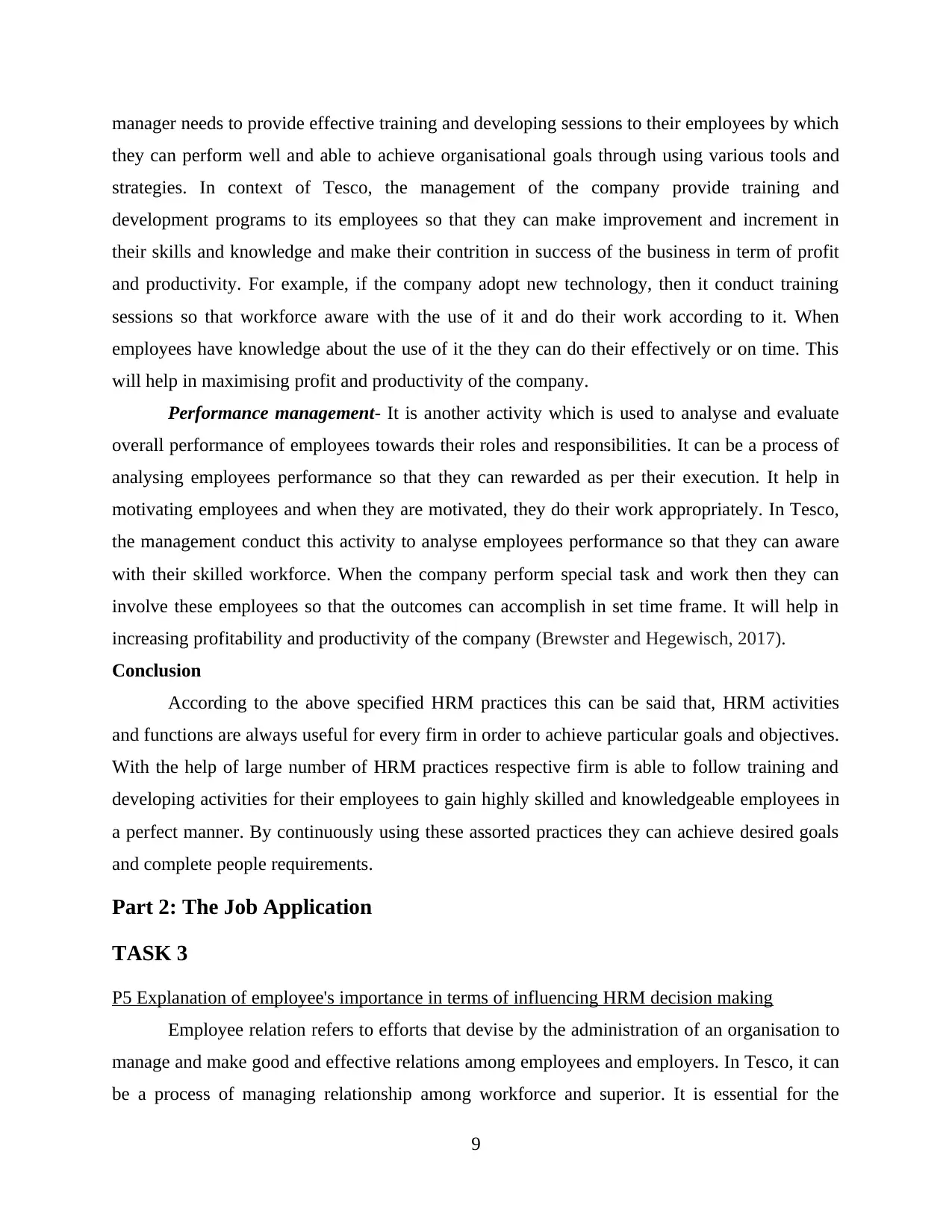
manager needs to provide effective training and developing sessions to their employees by which
they can perform well and able to achieve organisational goals through using various tools and
strategies. In context of Tesco, the management of the company provide training and
development programs to its employees so that they can make improvement and increment in
their skills and knowledge and make their contrition in success of the business in term of profit
and productivity. For example, if the company adopt new technology, then it conduct training
sessions so that workforce aware with the use of it and do their work according to it. When
employees have knowledge about the use of it the they can do their effectively or on time. This
will help in maximising profit and productivity of the company.
Performance management- It is another activity which is used to analyse and evaluate
overall performance of employees towards their roles and responsibilities. It can be a process of
analysing employees performance so that they can rewarded as per their execution. It help in
motivating employees and when they are motivated, they do their work appropriately. In Tesco,
the management conduct this activity to analyse employees performance so that they can aware
with their skilled workforce. When the company perform special task and work then they can
involve these employees so that the outcomes can accomplish in set time frame. It will help in
increasing profitability and productivity of the company (Brewster and Hegewisch, 2017).
Conclusion
According to the above specified HRM practices this can be said that, HRM activities
and functions are always useful for every firm in order to achieve particular goals and objectives.
With the help of large number of HRM practices respective firm is able to follow training and
developing activities for their employees to gain highly skilled and knowledgeable employees in
a perfect manner. By continuously using these assorted practices they can achieve desired goals
and complete people requirements.
Part 2: The Job Application
TASK 3
P5 Explanation of employee's importance in terms of influencing HRM decision making
Employee relation refers to efforts that devise by the administration of an organisation to
manage and make good and effective relations among employees and employers. In Tesco, it can
be a process of managing relationship among workforce and superior. It is essential for the
9
they can perform well and able to achieve organisational goals through using various tools and
strategies. In context of Tesco, the management of the company provide training and
development programs to its employees so that they can make improvement and increment in
their skills and knowledge and make their contrition in success of the business in term of profit
and productivity. For example, if the company adopt new technology, then it conduct training
sessions so that workforce aware with the use of it and do their work according to it. When
employees have knowledge about the use of it the they can do their effectively or on time. This
will help in maximising profit and productivity of the company.
Performance management- It is another activity which is used to analyse and evaluate
overall performance of employees towards their roles and responsibilities. It can be a process of
analysing employees performance so that they can rewarded as per their execution. It help in
motivating employees and when they are motivated, they do their work appropriately. In Tesco,
the management conduct this activity to analyse employees performance so that they can aware
with their skilled workforce. When the company perform special task and work then they can
involve these employees so that the outcomes can accomplish in set time frame. It will help in
increasing profitability and productivity of the company (Brewster and Hegewisch, 2017).
Conclusion
According to the above specified HRM practices this can be said that, HRM activities
and functions are always useful for every firm in order to achieve particular goals and objectives.
With the help of large number of HRM practices respective firm is able to follow training and
developing activities for their employees to gain highly skilled and knowledgeable employees in
a perfect manner. By continuously using these assorted practices they can achieve desired goals
and complete people requirements.
Part 2: The Job Application
TASK 3
P5 Explanation of employee's importance in terms of influencing HRM decision making
Employee relation refers to efforts that devise by the administration of an organisation to
manage and make good and effective relations among employees and employers. In Tesco, it can
be a process of managing relationship among workforce and superior. It is essential for the
9
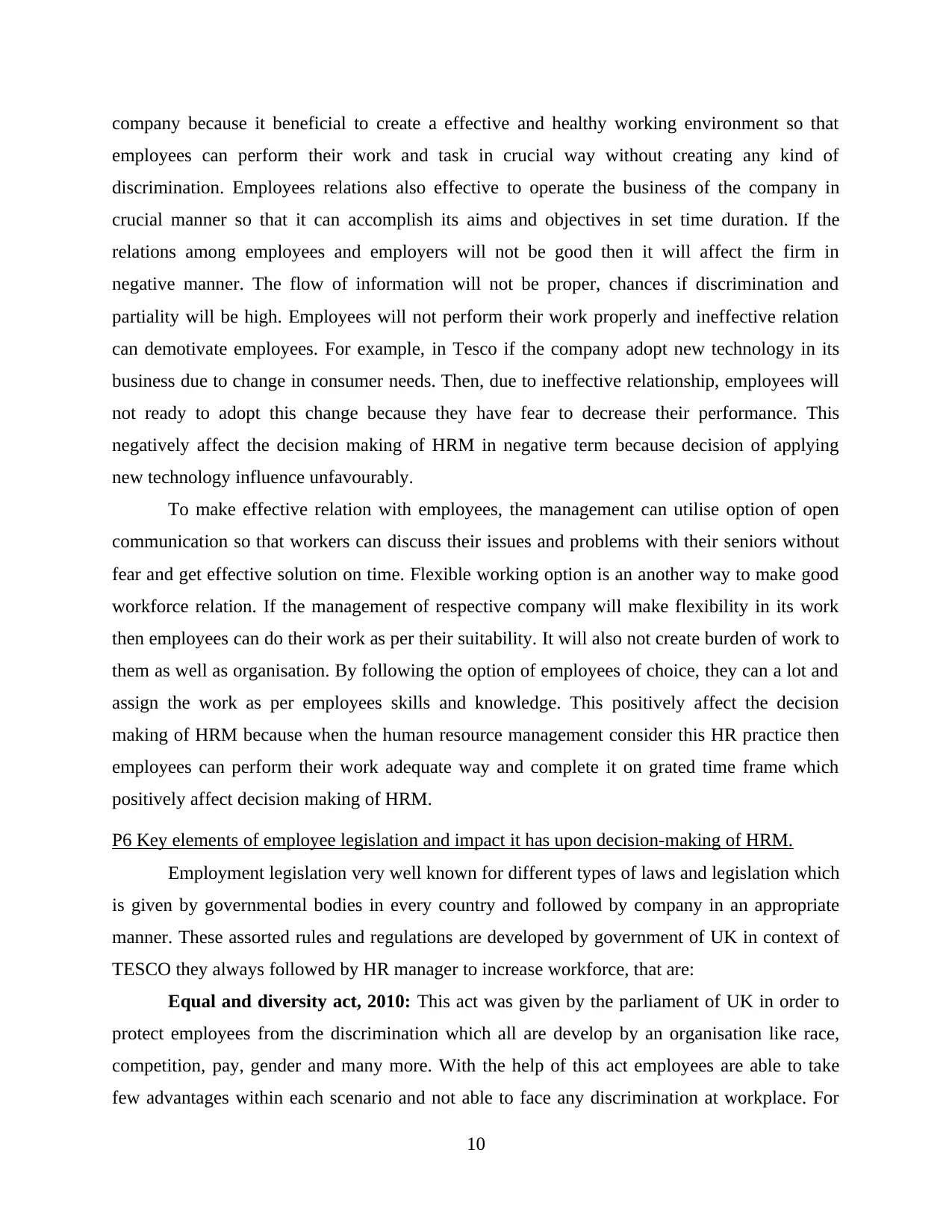
company because it beneficial to create a effective and healthy working environment so that
employees can perform their work and task in crucial way without creating any kind of
discrimination. Employees relations also effective to operate the business of the company in
crucial manner so that it can accomplish its aims and objectives in set time duration. If the
relations among employees and employers will not be good then it will affect the firm in
negative manner. The flow of information will not be proper, chances if discrimination and
partiality will be high. Employees will not perform their work properly and ineffective relation
can demotivate employees. For example, in Tesco if the company adopt new technology in its
business due to change in consumer needs. Then, due to ineffective relationship, employees will
not ready to adopt this change because they have fear to decrease their performance. This
negatively affect the decision making of HRM in negative term because decision of applying
new technology influence unfavourably.
To make effective relation with employees, the management can utilise option of open
communication so that workers can discuss their issues and problems with their seniors without
fear and get effective solution on time. Flexible working option is an another way to make good
workforce relation. If the management of respective company will make flexibility in its work
then employees can do their work as per their suitability. It will also not create burden of work to
them as well as organisation. By following the option of employees of choice, they can a lot and
assign the work as per employees skills and knowledge. This positively affect the decision
making of HRM because when the human resource management consider this HR practice then
employees can perform their work adequate way and complete it on grated time frame which
positively affect decision making of HRM.
P6 Key elements of employee legislation and impact it has upon decision-making of HRM.
Employment legislation very well known for different types of laws and legislation which
is given by governmental bodies in every country and followed by company in an appropriate
manner. These assorted rules and regulations are developed by government of UK in context of
TESCO they always followed by HR manager to increase workforce, that are:
Equal and diversity act, 2010: This act was given by the parliament of UK in order to
protect employees from the discrimination which all are develop by an organisation like race,
competition, pay, gender and many more. With the help of this act employees are able to take
few advantages within each scenario and not able to face any discrimination at workplace. For
10
employees can perform their work and task in crucial way without creating any kind of
discrimination. Employees relations also effective to operate the business of the company in
crucial manner so that it can accomplish its aims and objectives in set time duration. If the
relations among employees and employers will not be good then it will affect the firm in
negative manner. The flow of information will not be proper, chances if discrimination and
partiality will be high. Employees will not perform their work properly and ineffective relation
can demotivate employees. For example, in Tesco if the company adopt new technology in its
business due to change in consumer needs. Then, due to ineffective relationship, employees will
not ready to adopt this change because they have fear to decrease their performance. This
negatively affect the decision making of HRM in negative term because decision of applying
new technology influence unfavourably.
To make effective relation with employees, the management can utilise option of open
communication so that workers can discuss their issues and problems with their seniors without
fear and get effective solution on time. Flexible working option is an another way to make good
workforce relation. If the management of respective company will make flexibility in its work
then employees can do their work as per their suitability. It will also not create burden of work to
them as well as organisation. By following the option of employees of choice, they can a lot and
assign the work as per employees skills and knowledge. This positively affect the decision
making of HRM because when the human resource management consider this HR practice then
employees can perform their work adequate way and complete it on grated time frame which
positively affect decision making of HRM.
P6 Key elements of employee legislation and impact it has upon decision-making of HRM.
Employment legislation very well known for different types of laws and legislation which
is given by governmental bodies in every country and followed by company in an appropriate
manner. These assorted rules and regulations are developed by government of UK in context of
TESCO they always followed by HR manager to increase workforce, that are:
Equal and diversity act, 2010: This act was given by the parliament of UK in order to
protect employees from the discrimination which all are develop by an organisation like race,
competition, pay, gender and many more. With the help of this act employees are able to take
few advantages within each scenario and not able to face any discrimination at workplace. For
10
⊘ This is a preview!⊘
Do you want full access?
Subscribe today to unlock all pages.

Trusted by 1+ million students worldwide
1 out of 20
Related Documents
Your All-in-One AI-Powered Toolkit for Academic Success.
+13062052269
info@desklib.com
Available 24*7 on WhatsApp / Email
![[object Object]](/_next/static/media/star-bottom.7253800d.svg)
Unlock your academic potential
Copyright © 2020–2025 A2Z Services. All Rights Reserved. Developed and managed by ZUCOL.





